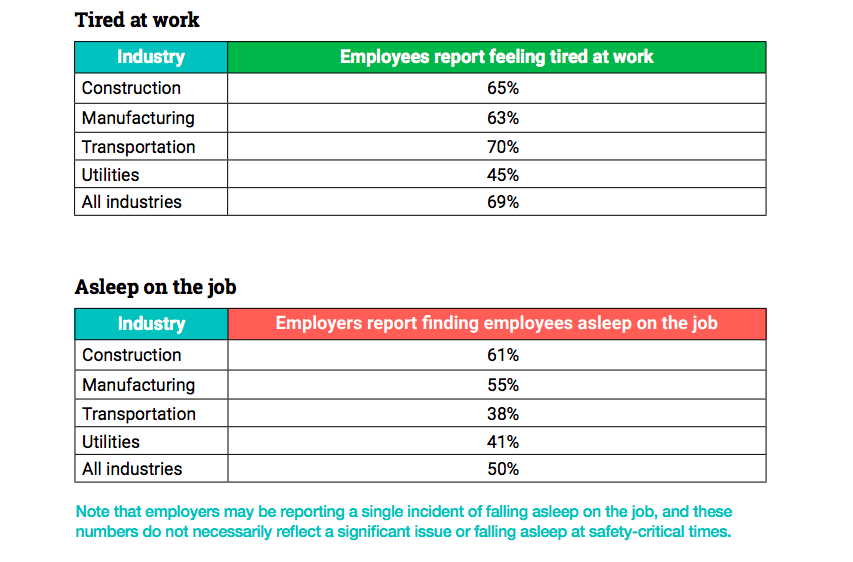NATIONAL SAFETY COUNCIL (NSC)
Executive Summary
 Annual productivity gains are part of many organizational goals. Employees may seek to increase their income by working more hours, and they have family and social obligations after work. Time for recovery rest breaks and restorative sleep seems like a luxury that fewer and fewer people and organizations provide. With all these factors, fatigue is becoming a major concern for U.S. employees and employers.
Annual productivity gains are part of many organizational goals. Employees may seek to increase their income by working more hours, and they have family and social obligations after work. Time for recovery rest breaks and restorative sleep seems like a luxury that fewer and fewer people and organizations provide. With all these factors, fatigue is becoming a major concern for U.S. employees and employers.
The impact of fatigue risk factors must be understood and addressed. Risk factors come from both employees and employers. In addition to the typical feeling of weariness at the end of a workday, fatigue can be caused by sleep disorders, sleep loss, working at night, putting in long hours and more. Fatigue affects employees’ ability to think clearly, slows reaction time, decreases attention and vigilance, and impacts short-term memory, judgment and other functions.
The National Safety Council surveyed employers and employees in 2017, gaining insight into the state of fatigue among both populations. In this report, we compare answers for the safety-critical industries of Construction, Manufacturing, Transportation and Utilities to the overall population. In general, we found that safety-critical industries experience equal or higher risk factors and impacts from fatigue. Throughout this report, NSC provides recommendations on actions that employers and employees can take to reduce the effects of fatigue.
There is a serious gap between how employers and employees view fatigue and its impact on their safety. Notably, 93% of all employers feel fatigue is a safety issue, but just 72% of employees agree. This indicates that employees are not good judges of their own fatigue, signaling a need for employers to invest in fatigue risk management systems (FRMS) and empower employees to participate in sleep health programs.
Other notable differences in survey responses from employers and employees in safety-critical industries include:
- 97% of the employers in the Transportation industry feel the impact of fatigue – the highest among all safety-critical industries surveyed. 66% reported decreases in productivity and 45% said they had experienced safety incidents.
- Nearly all—98%—of employers in Manufacturing said it is unsafe to drive while tired, but just 77% of employees in that industry agreed.
- Every Construction industry employee surveyed reported at least one risk factor for fatigue (see page 13). Of those workers, 46% said they work during high-risk hours, and 77% said they have demanding jobs.
- Transportation industry employees who reported at least one risk factor cited long shifts (42%) and sleep loss (48%) as the most common causes of fatigue.
***
Impact of Fatigue
Employers and employees agree that fatigue is a legitimate safety issue, but there is a large gap between the number of employers and employees who agree. This could point to differences in perception among employers and employees. Employers have objective ways to measure the effects of fatigue: productivity, absenteeism, safety incidents and injuries. Employees may not feel secure in reporting fatigue, and the company culture might consider fatigue to be a badge of honor. In addition, fatigue affects judgment, and therefore employees may not be capable of accurately judging when their performance is affected by fatigue (Dawson, 1997).
Tiredness and Falling Asleep on the Job
High numbers of employees report feeling tired at work and employers report employees falling asleep on the job. Transportation employees have the highest level of feeling tired at work (70%). While the percentage of Utilities employees who feel tired at work is lowest among the profiled industries, nearly 45% report feeling tired at work at least some of the time. Employees in Transportation and Utilities industries may not fall asleep less on the job; they may have more unsupervised hours at work, and therefore a decreased chance of being observed sleeping on the job by their employers.
Fatigue affects employees’ ability to think clearly, slows reaction time, decreases attention and vigilance, and impacts short-term memory, judgment and other functions. Tired employees are less effective (presenteeism) and more likely to miss work (absenteeism), creating a drag on productivity. Importantly for safety-critical industries, fatigued employees are also more likely to make mistakes that cause incidents and injuries. A 2014 meta-analysis of 27 observational studies estimated up to 13% of workplace injuries could be attributed to fatigue, and workers with sleep problems had a 1.62 times higher risk of being injured than those without (Uehli, 2014).
Up to 13% of workplace injuries could be attributed to fatigue.
 Find out how much fatigue costs your company. Enter four data points and your email address in the Real Costs of Fatigue Calculator at nsc.org/tiredatwork to get your customized results.
Find out how much fatigue costs your company. Enter four data points and your email address in the Real Costs of Fatigue Calculator at nsc.org/tiredatwork to get your customized results.
Download full version (PDF): Fatigue in Safety-Critical Industries (requires sign in)
About the National Safety Council (NSC)
www.nsc.org
The National Safety Council eliminates preventable deaths at work, in homes and communities, and on the road through leadership, research, education and advocacy.
Tags: fatigue, National Safety Council, NSC, safety-critical industries, sleep loss, worker fatigue







 RSS Feed
RSS Feed